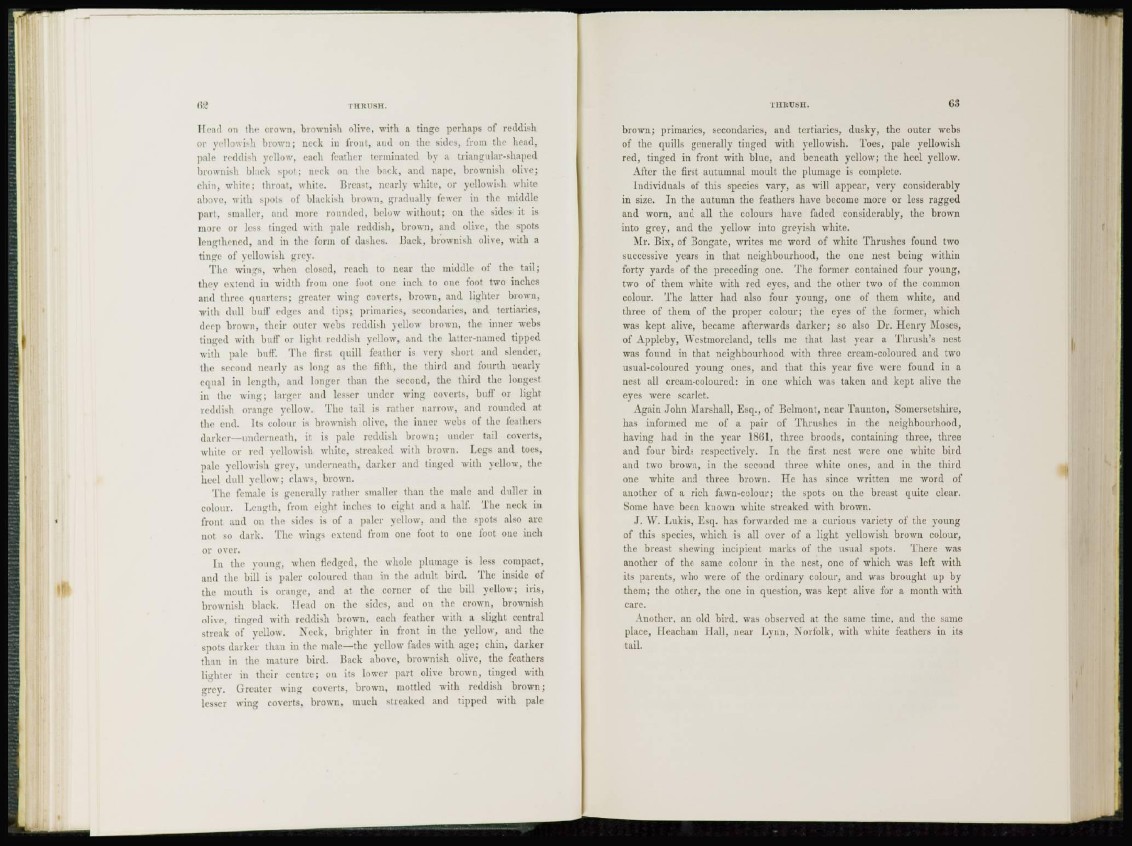
Head on the crown, brownish olive, with a tinge perhaps of reddish
or yellowish brown; neck in front, and on the sides, from the head,
pale reddish yellow, each feather, terminated by a triangular-shaped
brownish black spot; neck on the back, and nape, brownish olive;
chin, white; throat, white. Breast, nearly white, or yellowish white
above, with spots of blackish brown, gradually fewer in the middle
part, smaller, and more rounded, below without; on the sides it is
mon- or h - s s tinged with pale reddish, brown, and olive, the spots
lengthened, and in the form of d a s h e s . Hack, brownish (dive, with a
tinge of yellowish grey.
The wings, when closed, reach to near the middle of the tail;
they extend in width from one foot one inch to one foot two inches
and three quarters; greater wing coverts, brown, and lighter brown,
with dull bull' edges and tips; primaries, secondaries, and tertiaries,
deep brown, their outer webs reddish yellow brown, the inner webs
tinged with buff or light reddish yellow, and the latter-named tipped
with pale buff. The first quill feather is very short and slender,
the second nearly as long as the fifth, the third and fourth nearly
equal in length, and longer than the second, the third the longest
in the wing; larger and lesser under wing coverts, buff or light
reddish orange yellow. The tail is rather narrow, and rounded at
the end. Its colour is brownish olive, the inner webs of the feathers
darker-—underneath, it is pale reddish brown; under tail coverts,
white or red yellowish white, streaked with brown. Legs and toes,
pale yellowish grey, underneath, darker and tinged with yellow, the
heel dull yellow; claws, In-own.
The female is generally rather smaller than the male and duller in
colour. Length, from eight inches to eight and a half. The neck in
front and on the sides is of a paler yellow, and the spots also are
not so dark. The wings extend from one foot to one foot one inch
or over.
In the young, when Hedged, the whole plumage is less compact,
and the bill is paler coloured than in the adult bird. The inside of
the mouth is orange, ami at the corner of the bill yellow; iris,
brownish black. Head on the sides, and on the crown, brownish
olive, tinged with reddish brown, each feather with a slight central
streak of yellow. Neck, brighter in front in the yellow, and the
spots darker than in the male—-the yellow fades with age; chin, darker
than in the mature bird. Back above, brownish olive, the feathers
lighter in their centre; on its lower part olive brown, tinged with
grey. Greater wing coverts, brown, mottled with reddish brown;
lesser wing coverts, brown, much streaked and tipped with pale
brown; primaries, secondaries, and tertiaries, dusky, the outer webs
of the quills generally tinged with yellowish. Toes, pale yellowish
red, tinged in front with blue, and beneath yellow; the heel yellow.
After the first autumnal moult the plumage is complete.
Individuals of this species vary, as will appear, very considerably
in size. In the autumn the feathers have become more or less ragged
and worn, and all the colours have faded considerably, the brown
into grey, and the yellow into greyish white.
Mr. Bix, of Bongate, writes me word of white Thrushes found two
successive years in that neighbourhood, the one nest being within
forty yards of the preceding one. The former contained four young,
two of them white with red eyes, and the other two of the common
colour. The latter had also four young, one of them white, and
three of them of the proper colour; the eyes of the former, which
was kept alive, became afterwards darker; so also Dr. Henry Moses,
of Appleby, Westmoreland, tells me that last year a Thrush's nest
was found in that neighbourhood with three cream-coloured and two
usual-coloured young ones, and that this year five were found in a
nest all cream-coloured: in one which was taken and kept alive the
eyes were scarlet.
Again John Marshall, Esq., of Belmont, near Taunton, Somersetshire,
has informed me of a pair of Thrushes in the neighbourhood,
having had in the year 18bT, three broods, containing three, three
and four birds respectively. In the first nest were one white bird
and two brown, in the second three white ones, and in the third
one white and three brown. He has since written me word of
another of a rich fawn-colour; the spots on the breast quite clear.
Some have been known white streaked with brown.
J. W. Lukis, Esq. has forwarded me a curious variety of the young
of this species, which is all over of a light yellowish brown colour,
the breast shewing incipient marks of the usual spots. There was
another of the same colour in the nest, one of which was left with
its parents, who were of the ordinary colour, and was brought up by
them; the other, the one in question, was kept alive for a month with
care.
Another, an old bird, was observed at the same time, and the same
place, Ileacham Hall, near Lynn, Norfolk, with white feathers in its
tail.